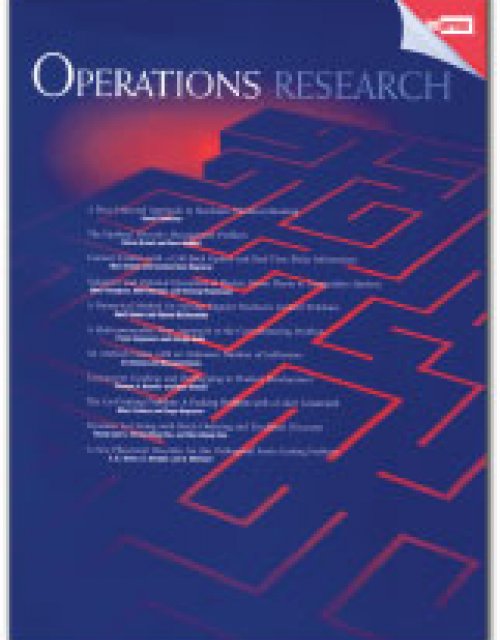Publication records
Subject(s)
Human resources management/organizational behavior; Management sciences, decision sciences and quantitative methods; Strategy and general management
Keyword(s)
Status, performance feedback theory, decision making, college
rankings, Chivas Regal effect, pricing, signaling
This paper examines the effect of status loss on organizations’ price-setting behavior. We predict, counter to current status theory and aligned with performance feedback theory, that a status decline prompts certain organizations to charge higher prices and that there are two kinds of organizations most prone to make such price increases: those with broad appeal across disconnected types of customers and those whose most strategically similar rivals have charged high prices previously. Using panel data from U.S. News & World Report’s annual rankings of private colleges and universities from 2005 to 2012, we model the effect of drops in rank that take a school below an aspiration level. We find that schools set tuition higher after a sharp decline in rank, particularly those that appeal widely to college applicants and whose rivals are relatively more expensive. This study presents a dynamic conception of status that differs from the prevailing view of status as a stable asset that yields concrete benefits. In contrast to past work that has assumed that organizations passively experience negative effects when their status falls, our results show that organizations actively respond to status loss. Status is a performance related goal for such producers, who may increase prices as they work to recover lost ground after a status decline.
With permission of Sage
Volume
61
Journal Pages
217–253
Subject(s)
Management sciences, decision sciences and quantitative methods; Marketing
Keyword(s)
Market research, customer satisfaction, satisfaction attributes
JEL Code(s)
M30, M310
Secondary Title
Jahrbuch Markt- und Sozialforschung Schweiz 2016
Pages
12–15
Subject(s)
Management sciences, decision sciences and quantitative methods
Keyword(s)
Equal division, weighted division values, non-negative player, addition invariance on bi-partitions, nullified solidarity
Volume
80
Journal Pages
649–667
Subject(s)
Information technology and systems; Technology, R&D management
Keyword(s)
Strategic perspective, strategy implications, strategic management, strategy, innovation, IS/IT systems
A comprehensively updated revision of a book regarded by many as one the leading and authoritative titles for practitioners, academics and students in the domain of information systems and technology (IS/IT) strategy. Presents a structured framework with tools, techniques and ways of thinking which provide a practical approach to building a digital strategy, expressed primarily in the language of business and management. Brings together the implications of the significant advances in IT and the most useful current thinking, research, and experiences concerning the business impact and strategic opportunities created by IS/IT. Peppard and Ward discuss the key questions that managers have to grapple with of where, when and how to invest in IS/IT, which is why a IS/IT (or digital) strategy is required.
Volume
4th ed.,
Pages
504
ISBN
978-0-470-03467-5
Subject(s)
Economics, politics and business environment
Keyword(s)
Retail competition, externalities, free-riding, vertical restraints, cross-channel shopping, competition law
JEL Code(s)
K21, L42, L81
Volume
4
Journal Pages
42–83
Subject(s)
Management sciences, decision sciences and quantitative methods; Product and operations management
Keyword(s)
Dynamic mechanism design, optimal control, asymmetric information, environmental regulation, voluntary disclosure
This paper studies the design of voluntary disclosure regulations for a firm that faces a stochastic environmental hazard. The occurrence of such a hazard is known only to the firm. The regulator, if finding a hazard, collects a fine and mandates the firm to perform costly remediation that reduces the environmental damage. The regulator may inspect the firm at any time to uncover the hazard. However, because inspections are costly, the regulator also offers a reward to the firm for voluntarily disclosing the hazard. The reward corresponds to either a subsidy or a reduced fine, depending on whether it is positive or negative. Thus, the regulator needs to dynamically determine the reward and inspection policy that minimizes expected societal cost in the long run. We model this problem as a dynamic adverse selection problem with costly state verification in continuous time. Despite the complexity and generality of this setup, we show that the optimal regulation policy follows a very simple cyclic structure, which we fully characterize in closed form. Specifically, the regulator runs scheduled inspections periodically. After each inspection, the reward level decreases over time until a subsequent inspection takes place. If a hazard is not revealed, the reward level is reset to a high level, restarting the cycle. In contrast to the reward level, the mandated remediation level is constant over time. Nonetheless, when subsidies are not allowed in the industry, we show that the regulator should dynamically adjust this remediation level, which then acts as a substitute for a subsidy. Our analysis further reveals that optimal inspection frequency increases not only when the inspection accuracy decreases, but also when the penalty for not disclosing the hazard increases.
© 2016 INFORMS
Volume
64
Journal Pages
371–389
Subject(s)
Product and operations management
Keyword(s)
Reusability, reuse, innovation, Markov decision process
Many industries, including consumer electronics and telecommunications equipment, are characterized with
short product life-cycles, constant technological innovations, rapid product introductions, and fast obsolescence. Firms in such industries need to make frequent design changes to incorporate innovations, and the
effort to keep up with the rate of technological change often leaves little room for the consideration of product
reuse. In this paper, we study the design for reusability and product reuse decisions in the presence of both
a known rate of incremental innovations and a stochastic rate of radical innovations over time. We formulate
this problem as a Markov Decision Process. Our steady-state results confirm the conventional wisdom that a
higher probability of radical innovations would lead to reductions in the firm's investments in reusability as
well as the amount of reuse the firm ends up doing. Interestingly, the design for reusability decreases much
more slowly than the actual reuse. We identify some specific scenarios, however, where there is no tradeoff
between the possibility of radical innovations and the firms reusability and reuse decisions. Based on over
425,000 problem instances generated over the entire range of model parameters, we also provide insights
into the negative impact of radical innovations on firm profits, but show that the environmental impact of
increased radical innovation is not necessarily negative. Our results also have several implications for policy
makers seeking to encourage reuse.
short product life-cycles, constant technological innovations, rapid product introductions, and fast obsolescence. Firms in such industries need to make frequent design changes to incorporate innovations, and the
effort to keep up with the rate of technological change often leaves little room for the consideration of product
reuse. In this paper, we study the design for reusability and product reuse decisions in the presence of both
a known rate of incremental innovations and a stochastic rate of radical innovations over time. We formulate
this problem as a Markov Decision Process. Our steady-state results confirm the conventional wisdom that a
higher probability of radical innovations would lead to reductions in the firm's investments in reusability as
well as the amount of reuse the firm ends up doing. Interestingly, the design for reusability decreases much
more slowly than the actual reuse. We identify some specific scenarios, however, where there is no tradeoff
between the possibility of radical innovations and the firms reusability and reuse decisions. Based on over
425,000 problem instances generated over the entire range of model parameters, we also provide insights
into the negative impact of radical innovations on firm profits, but show that the environmental impact of
increased radical innovation is not necessarily negative. Our results also have several implications for policy
makers seeking to encourage reuse.
View all ESMT Working Papers in the ESMT Working Paper Series here. ESMT Working Papers are also available via SSRN, RePEc, EconStor, and the German National Library (DNB).
Pages
36
ISSN (Print)
1866–3494
Subject(s)
Economics, politics and business environment
Keyword(s)
Rekommunalisierung, Wettbewerbliche Effekte, Deutschland, Mixed oligopoly, Entsorgungswirtschaft
JEL Code(s)
L33, H76, Q53
Diese Studie untersucht Trends in der Rekommunalisierung in der Entsorgungswirtschaft in Deutschland, analysiert mögliche Erklärungsansätze und überprüft diese empirisch. Wir finden Hinweise auf eine Rekommunalisierungsspirale: Kommunalisierung in der Vergangenheit verstärkt die Anreize für Kommunen zur Kommunalisierung in der Zukunft. Dies liegt, so unsere Vermutung, zum einen an „Ausstrahlwirkungen“ von benachbarten Kommunen, zum anderen an der sinkenden kommerziellen Attraktivität privater Angebote in einem schrumpfenden Wettbewerbsmarkt. Damit können von der Option der kommunalen Eigenerstellung wettbewerbliche Effekte ausgehen. Auf Basis der empirischen Ergebnisse schlägt diese Studie einen Test vor, ob Kommunen die Möglichkeit und den Anreiz zur Rekommunalisierung haben, um zu prüfen, ob die Option der kommunalen Eigenerstellung wettbewerbliche Effekte haben kann.
Pages
69
ISSN (Print)
1866–4016
Subject(s)
Marketing
Keyword(s)
Corporate social responsibility, csr, price fairness
JEL Code(s)
M310
Subject(s)
Economics, politics and business environment
Keyword(s)
Labor contracts, incentives, behavioral economics, plantations
JEL Code(s)
D82, D86, J33, J41, J43, O13, Q12
We study a contract change for tea pluckers on an Indian plantation, with a higher government-stipulated baseline wage. Incentive piece rates were lowered or kept unchanged. Yet, in the following month, output increased by 20 to 80 percent. This response contradicts the standard model and several variants, is only partly explicable by greater supervision, and appears to be "behavioral." But in subsequent months, the increase is comprehensively reversed. Though not an unequivocal indictment of "behavioral" models, these findings suggest that nonstandard responses may be ephemeral, and should ideally be tracked over an extended period of time.
Copyright © 2016 by the American Economic Association.
Volume
106
Journal Pages
316–358

